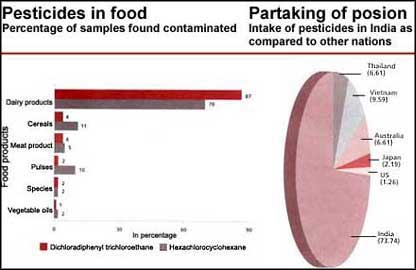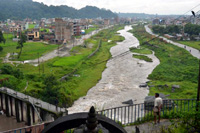
For the people...
Conservation policies practised in the developing world need to tread cautiously on territories which had for generations, belonged to the people, says a statement by the Centre for Science and Environment

Conservation policies practised in the developing world need to tread cautiously on territories which had for generations, belonged to the people, says a statement by the Centre for Science and Environment

Western institutions and the United Nations are keen protagonists of natural resource accounting but it may still not be a useful policy tool for planners to promote sustainable development. Experience in the Philippines has shown that only an elaborate c

Complex systems of preserving biodiversity, evolved over centuries, have not saved traditional communities living in bio rich areas like India from poverty. Only if India starts patenting its germplasm can it compensate those of its communities which have
Dr. S. Ramani, senior scientist Agricultural Entomology , Project Directorate of Biological Control Indian Council of Agricultural Research , Bangalore speaks to Down To Earth

As the reckless plundering of the world"s limited resources continues, nature is striking back where it hurts humans most: disease. People in some places are still paying the price of other people"s progress. So what makes planners think that they have a

Away from human interference, the virgin Arctic islands are, ironically, more polluted than the distant industrialised settlements. And the reason is a filthy secret

After generating a lot of scientific interest worldwide, neem is now attracting pesticide manufacturers and pharmaceuticals keen to exploit its various properties.

A sturdy mountain tree could transform chilly deserts into lush fields

Indian farmers are busy harvesting the booming demand for mushrooms. The problem is that it is a delicacy that is rather fastidious about its growing requirements

The ministry of environment and forests" plan to conserve biodiversity excludes the people.

Biotechnology issues pose tremendous challenges for developing countries. As a member of the World Trade Organisation, India will have to gear up to protect its biodiversity, the interests of its indigenous communities and their know how

As the global demand for paper rockets, forests in the Asia Pacific are being targeted for paper plantations

Despite a government ban on use of some common pesticides in agriculture, our food continues to be contaminated. The there is no alternative factor, ie the absence of more acceptable substitutes, the cost factor and the easy availability of the pesticide

Research in atmospheric sciences is booming because of the impending threat to4he world's climate. Every month there is a new study showing new sources of greenhouse gases rages that are capable of producing global warming or disputing earlier

From major fruits like the mango, banana and citrus to minor ones like karonda and sapthei, the story is the same: genetic erosion is leading India's native fruits to the brink of extinction
Spring is not far away and the villagers of Gatana, Paro know it well. But the farmers are not in a hurry - they know they will finish their work well in time. With the sound of few power-tillers echoing from the hills, that enclose the village located below Dzongdaka monastery, Gatana farmers say that what they did in a week's time in the past can now be done in a day. Behind all their confidence is the power-tiller, what many farmers call the farmer's norbu (precious jewel). What was once considered a status symbol has become a practical necessity to farmers all over the country. It is, in the words of one of the first power-tiller owners in Paro, Tshering Pem, an "agent of change' in Bhutanese farming. Tshering Pem, 68, recalls the first day when her late husband, a former gup brought home a power-tiller in 1981. "All my neighbours came with tea and khadar to celebrate the occasion. I didn't know why then,' she said with a contented smile. "I do now. It became so significant in my life,' added the successful farmer. A multipurpose machine - from fetching water to ploughing fields to ferrying people About a kilometre below Tshering Pem's house, the Agriculture Machinery Centre is hosting another significant function. The Japanese government is handing over 179 power-tillers to the centre under the KRII grant, which will travel to various dzongkhags to make a difference in the lives of farmers. "Nothing can beat the power-tiller,' says farmer Lhamu in Lobesa. "From fetching water to ploughing fields to ferrying people, it can do it all,' says Lhamu. "Without it, farming would be difficult or, at least, different.' Many farmers like Lhamu feel that farming would indeed be difficult without power tillers. One of the immediate benefits, according to farmer Thanka, was that it solved the problem of labour shortage. "With every parent knowing the value of education, there were no hands left to help on the farm,' said the former gup. "Power-tillers came as a blessing. It can do both men's and women's work. Moreover, it can do 20 men's work in a day.' Aum Tshering Pem recalls how her neighbors relied on her power-tiller to help them. "It was like magic as it tilled terrace after terrace within minutes,' she says. "Many people stopped their work and watched it for hours.' A prosperous farmer, Aum Tshering Pem says the power-tiller is more valuable than her Toyota land cruiser. Farmers run short of adjectives when asked how power-tillers changed their lives. According to one of the early owners in Paro, Gup Dep Dorji in Shari, for many farmers, they are valued more than their parents. "There are no words to describe how it helped Bhutanese farmers,' he says. Dorji bought his tiller in 1987 and boasts that it still works fine. "The greatest thing the tiller brought to farmers was that it relieved both men and women of their drudgery,' he says. "It's a multipurpose machine. I'd prefer it to a truck.' Dorji has a long list of what the tiller can do, and says that it enhanced farmer's income from cash and food crops and made many self sufficient. "From the same area of land, yields are almost doubled when a tiller is used,' he says. AMC officials say that a power-tiller can till 1 to 1.5 acres of land in a day. "That would be the work of four pairs of bulls,' said the official. A power tiller can plough, transplant rice, thresh paddy, and pump water, besides doing many other domestic work. Aum Tshering Pem's village, with about 30 households, has now about 15 power-tillers. AMC's administrative officer, Wangchuk, who served with the centre since its inception in 1984, says that he has witnessed a sea-change since the machine's intervention in Bhutanese farming. "It has helped farmers improve yield, save cost, and lessened drudgery,' he says. "Today, it has become indispensable in farming.' The tillers from the KRII grant are sold at a subsidized rate to farmers. However, the cost of one has gone up from Nu 19,500 in 1983 to about Nu 112,000 now. Wangchuk said that the centre tied up with Bhutan Development Finance Corporation to lend farmers money to purchase the machines. "Today, farmers buy, even paying cash down,' he says. According to the centre's engineer, Kinga Norbu, because of the demand, distribution is done to ensure that every dzongkhag gets the machine. He said that Paro, Punakha, Wangduephodrang have the highest demand, but preference is given to farmers' groups. The demand for power-tillers is so high that a few private firms have started importing them from China and India. Paro has the highest number of power tillers at 458, followed by Punakha with 241, and Wangdue with 221. Remote dzongkhags like Zhemgang have 40 and Gasa 34. Yesterday, at the handing-over ceremony, the programme director of the centre, Chetem Wangchen, said that the popularity of the tiller has become evident with a huge surge in demand. More than 800 farmers have already applied for tillers since last year. From 30 sold in the first lot in 1983, AMC has distributed 2,180 to date. Meanwhile, the list of the KRII grant, the 20th instalment, was handed over to the agriculture secretary, Sherub Gyeltshen, by Mr Keizo Takewaka, minister, Japanese Embassy in New Delhi, India. At the ceremony, the minister commended the agriculture ministry for their policy in mechanizing agriculture and said that the Japanese government was happy to see their assistance put to best use in Bhutan. "We're happy to see that our assistance is helping the development of agriculture and rural farmers,' said Mr Keizo Takewaka. The agriculture secretary, Sherub Gyeltshen said that the KRII grant is an unprecedented and unique grant from the Japanese government in achieving Bhutan's food self sufficiency policy and developing agriculture. "The grant has benefitted Bhutanese farmers, especially when most are dependent on agriculture, farmlands are located in difficult terrain and when there is an acute shortage of farm labour,' he said. Back in Gatana, two men are taking their power-tiller home after a day's work. "I've made Nu 3,000 from hiring out my tiller today,' says the proud owner of the tiller. "It will be enough for my daughter's shopping when she goes back to school.' By Ugyen Penjore ugyenpen@kuensel.com.bt

<p><span style="font-size:14px;"><strong>Bagmati River</strong></span></p> <p><img alt="" src="http://www.indiaenvironmentportal.org.in/files/country/nepal/bagmati_hl.jpg" style="border-width: 2px; border-style: solid;" /></p> <p>The Bagmati Action Plan is the latest attempt to heal the river system, from its origins in the Shivapuri hills to Chouva where it leaves the valley. It was launched in 2008 for the period 2009-14, and proposes a budget of close to 15 billion Nepalese rupees spread over five years (in comparison, in 2008 – 2009, the total allocated for the Bagmati and its tributaries was Rs. 1,394.24 million).</p>
<table border="0" cellpadding="0" cellspacing="0" width="210px"> <tbody> <tr> <td bgcolor="#363636" colspan="2" height="26px" style="color: rgb(255, 255, 255); font-size: 14px; padding-left:5px;"> Editor's Pick</td> </tr> </tbody> </table> <p><iframe frameborder="0" height="380" marginheight="0" marginwidth="0" scrolling="no" src="http://www.indiaenvironmentportal.org.in/files/country/bangladesh/bangladesh_iframe.htm" style="border-width:0px; border-color:#333; background:#FFF; border-style:solid;" width="555"></iframe></p> <hr /> <table border="0" cellpadding="0" cellspacing="0" width="210px"> <tbody> <tr> <td bgcolor="#363636" colspan="2" height="26px" style="color: rgb(255, 255, 255); font-size: 14px; padding-left:5px;"> Country Overview</td> </tr> </tbody> </table> <table border="0" cellpadding="1" cellspacing="1" style="width: 540px;"> <tbody bgcolor="#F0F0F0"> <tr> <td> <p><iframe align="right" frameborder="1" height="310" marginheight="0" marginwidth="0" scrolling="no" src="https://maps.google.co.in/maps?f=q&source=s_q&hl=en&geocode=&q=bangladesh&aq=&sll=20.984928,82.752628&sspn=45.458666,56.513672&ie=UTF8&hq=&hnear=Bangladesh&t=m&ll=23.684774,90.351563&spn=3.42031,3.724365&z=7&output=embed" width="330"></iframe><span style="font-family:arial,helvetica,sans-serif;"><span style="font-size: 12px;">Bangladesh is located between 20 º 34 to 26º 38 north latitude and 88.01 º to 92.42 º east longitude, with an area of 147,570 sq km). With a population of 164.000 million, Bangladesh is one of the world's most densely populated countries.</span></span></p> <p><span style="font-family:arial,helvetica,sans-serif;"><span style="font-size: 12px;">It has a border on the west, north, and east with India, on the southeast with Myanmar, and the Bay of Bengal is to the south. Geologically, Bangladesh is a part of the Bengal Basin, one of the largest geosynclinals in the world.</span></span></p> <p><span style="font-family:arial,helvetica,sans-serif;"><span style="font-size: 12px;">The Basin is bordered on the north by the steep Tertiary Himalayas; on the northeast and east by the late Tertiary Shillong Plateau, the Tripura hills of lesser elevation, and the Naga-Lusai olded belt; and in the west by the moderately high, ancient Chotanagpur plateau.</span></span></p> </td> </tr> </tbody> </table>
<p>With relations between countries now being shaped by geo-economics rather than geo-politics, an emerging issue is to what extent the United States, China and India, all populous countries and top tier

Controversy has dogged the Konkan railway project since its inception. Today, many influential Goans are up in arms against the present alignment of the track, which, they allege, would wreck the state"s environment. Railway officials, of course, disagree